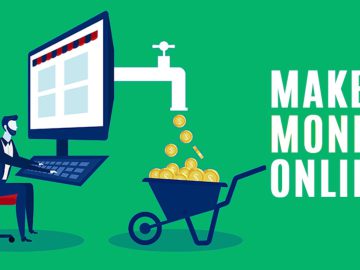It has been over a year since the pandemic started yet there are still many places on lockdown or under strict health protocols. But, there are things that can never be locked down, like creativity and innovation.
While many people have suffered from the pandemic, we have seen how resilient man is by how they have adapted to changes. One concrete example of this resilience is the growth in the Creator Economy, as people find new ways to make a living while pursuing their passions.
Creator Economy Trends You Should Watch Out For:
What is the Creator Economy?
The Creator Economy refers to the class of businesses built by independent creators and the companies that serve their needs. Independent creators include self-employed individuals, vloggers, bloggers, influencers, writers, artists, and anyone else who monetize their knowledge, skills, or creations.
The companies that provide creators with content creation tools, software systems, finance management, analytics programs and other platforms that can help them grow their income are also part of the Creator Economy.
Types of Creators

There are many types of content creators. Of the estimated 50 million creators today, only about two million consider themselves professional creators. The rest are amateur creators who earn some money from producing content but are not able to get enough revenue from this to sustain their daily living. Often, amateurs keep their day jobs and engage in their creative pursuits only less than 15 hours a week or even just once a month.
The income range for the different types of creators is broad, from mere dollars and cents for amateurs and hobbyists to millions of dollars for professionals with sensational content and well-thought out marketing strategies. Producing content for popular platforms and apps like YouTube, Instagram, and Twitch offer lucrative opportunities for income.
Creator income can be earned from acting, making or curating music, podcasting, blogging, writing, and illustrating.
Among the many types of creator content are:
- Apps
- Blog posts
- Comics, cartoons, and webtoons
- Courses
- eBooks
- Games
- How-To guides
- Infographics
- Literary works
- Live video
- Memes
- Newsletters
- Photos, illustrations, and other images
- Podcasts
- Slideshows
- Tools
- Videos and vlogs
- Webinars
- Wikis
Aside from creating and selling digital content, content makers can also earn from other activities, mainly through advertising and marketing. In fact, setting up a combination of sources and diversifying their income streams is a good way to make money in the creator economy.
Advertising and marketing revenue can be generated through selling ad space, creating or sharing sponsored content, featuring product placements, accumulating subscriptions, collecting tips, getting one-off sales and donations, receiving money from fan clubs, offering online courses, and selling fan engagement among others.
Evolution of the Creator Economy

The Creator Economy sprung from enterprising people with particular skills. These people started sharing and selling their digital content online. One of the earliest platforms, Teachable, made its mark when it hit a milestone in 2020, achieving $1 billion creator sales revenues. As content creation is highly dependent on tech tools, technological advancements greatly affect how content is created and shared or sold.
Technological Advancements
From the expensive high-end cameras and expensive software used for content creation many years ago, today’s more affordable consumer electronics and applications have significantly reduced production and distribution costs for creators. Even smartphones today can be used to produce pro-quality digital content, from taking photos and videos to editing and posting.
Development of the Gig Economy
The ease and convenience in a vast environment brought about by technological advancements have also given rise to the development of a gig economy where not only professional full-time creators earn a respectable income, but also freelancers and independent contractors taking on short-term work arrangements. It is not uncommon for content creators to work on a per project basis.
Emergence of Specialist Content Sites
Digital content is no longer available for ‘display’ and eventual consumption just from creator or sponsor websites. It is also no longer necessary for creators to be affiliated with a production company or to sign with a particular label.
Content sites that specialize on specific content types—like YouTube for videos, iTunes for music, and Amazon for ebooks—allow content creators to showcase their ‘wares’ for their audience or market to see and sample. Some platforms, like Teachable for online courses, even have onsite tools and templates to make it easier for content creators to produce, publish, and sell their digital content.
Development of Creative Social Media
Popular social media platforms have emerged too and have added more venues for content creators to earn income from. Without these platforms, it would be difficult and inconvenient (or even impractical to a certain extent) to develop, create, and share digital content.
The development and the pervasiveness of these specialist content sites and social platforms have been pivotal to the rise of the creator economy. Some would even exaggerate to say that there would be no creators if there were no platforms. More realistically, it would be difficult for creators to create content and make money out of it. It would thus not make sense for them to engage in content creation as a business endeavor.
The Creator Economy is quite robust, with content creators earning good money from such sites as YouTube, Spotify, iTunes, TikTok, Instagram, Facebook, and Twitch. On these platforms, digital content is consumed with such ‘hunger’ 24/7 by consumers all over the world. With high-quality and relevant content, content creators can surely make money in the creator economy ecosystem.
Current State of the Creator Economy
The numbers and metrics are not as clear yet when it comes to the financial analysis of the creator economy. Much has yet to be defined in this ecosystem beyond just knowing that creators and their audiences and consumers are ‘enjoying’ their online interactions.
The great potential for long-term growth in this economy has spurned a growing interest in venture capitalists who see that it will continue to boom in the coming years. Even career aspirations among the GenZ population have been observed to shift from professional white collar titles to the more interest-driven undertakings of being a content creator.
Platform figures in the hundreds of millions of dollars are indicative of how actively consumers are snapping up online content. According to Forbes, some $211 million were generated by YouTube channels from June of 2019 to June 2020.
Top content creators are able to earn big bucks even on a per content/post basis. Done continuously and consistently, a content creator can earn millions annually. For instance, top Instagram influencers can earn six-figure incomes on single posts. Top writers on Substack, on the other hand, can net upwards of $1 million every year.
Seeing as how active consumers are online these days, the current state of the creator economy is seen to be continuously on the upward trend. New creators are getting into the ecosystem, whether for personal reasons or with clear intentions to earn income out of it. New technology is also a great ‘enabler’ for newbies and old timers in content creation alike.
Creator Economy Trends to Watch Out For

Much can be expected out of the creator economy in the coming years. Bigger players and investors are taking notice of the opportunities in this economy. They see the value in capitalizing on content integration and in making use of the economy to further their brands and businesses.
It is highly likely that media giants will churn out more tools for monetization to entice content creators and encourage them to ‘keep it coming.’ Cross-platform sharing is also seen to be the norm, as it helps widen content reach.
Increased Investment in the Industry
In 2021 alone, the creator economy has seen an outstanding $1.3 billion in funding. This has been the highest cumulative annual investment so far. And, it is expected to increase in the next few years. Top investors and companies are taking note of the bright outlook for lucrative investments in this industry.
Brands Remain the Highest Revenue Source for Creators
Sponsorships still get the biggest slice of the pie when it comes to creator income. Approximately 77% of creators earn their revenue from brand deals. This is about three times as much as the revenue from all other sources combined. We see this trend continuing as brands continue to see the benefits of working with creators and influencers.
Increase in Cross-Platform Sharing
Most creators have accounts on multiple platforms. As these platforms make it easier for users to publish or share content across various channels, we see more creators utilizing cross-platform sharing to widen their reach.
Instagram is Still the Primary Content Channel for Creators
Over 72% of creators still prefer Instagram as their primary channel for publishing content. TikTok is also rising in popularity but still pales in comparison with only about 13% of creators choosing it as their primary channel. While the number of TikTok subscribers also continues to grow, it seems safe to assume that Instagram will remain the foremost platform for creators—at least, in the next couple of years.
Shift from Social Networks to Own Platforms
While social networks are scrambling to keep creators on their platforms, creators are now looking for ways to become less dependent on media giants. More and more are now finding ways to monetize their content through their own apps or sites. In the future, we are likely to see creators evolving into independent brands with their own monetization tools.
Engagement Rate Over Money
The recent survey by Influencer Marketing Hub shows that 17.11% of creators consider engagement rates as their top measure of success. While earning money is also important, creators primarily focus on increasing engagement and building a relationship with their audience. Even as the creator economy blooms, we can expect this measure of success to not change drastically.
From Faceless Publishers to Well-Known Personalities
Creators are not just mere unknown individuals churning out content. They are slowly gaining power in the complex world of media. As fans and followers seek to connect with them, they earn recognition and fame in the industry.
Creators will Become Founders

Aside from gaining more popularity, we can expect creators to become founders of their own businesses. They will likely build teams and assemble tools to increase their revenue sources and improve their production process while focusing on their art and passions.
More Fintech Companies Will Cater to Independent Creators
Traditional financial institutions have created gaps in financing for independent creators. Fintech companies, like Karat and Financial Venture Studio, are providing creators financing and lending services that they would otherwise not receive from traditional banks.
The Creator Economy is Expanding
There is definitely more room for growth in the creator economy, and its expansion is inevitable. As such, more competition can be expected among content creators. The challenge would lie in continuously producing high-quality content that consumers are willing to pay for and that are effective in achieving their brand partner’s business goals.
New content creators will continue to emerge as more and more people decide to follow their passions. People are finding it more appealing and productive to make money out of creating content that’s aligned with their passions or strengths. Earning income from the creator economy gives people the chance to pursue their true interests while addressing their financial needs.
As companies and brands increase their online presence and channel their budgets towards online advertising and promotions, more opportunities are seen for content creators.
The trend continues to move towards more personal accounts and testimonials on brand experiences, thus making influencer content in demand. Creator content would focus more and more on relevance and authenticity. This means that content creators would have to worry less about all the bells and whistles of hi-tech effects to attract audiences and promote their content.
About the Author
![]()
Writer
The Influencer Marketing Hub Team brings together a diverse group of experts with a passion for influencer marketing, digital trends, and social media strategies. Each piece of content crafted by this team is researched and written to provide valuable insights, tips, and updates for our readers. Our authors are dedicated to delivering high-quality, informative, and engaging articles that help businesses and influencers thrive in this rapidly changing digital world.





